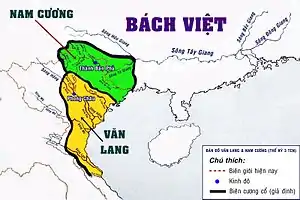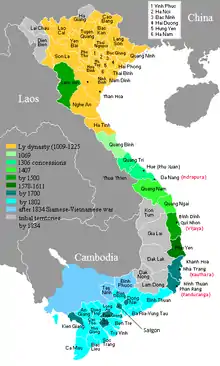
| History of Vietnam (by names of Vietnam) |
 | ||||||||||||||||||||||||||||||||||||||||||||||||||||||
|---|---|---|---|---|---|---|---|---|---|---|---|---|---|---|---|---|---|---|---|---|---|---|---|---|---|---|---|---|---|---|---|---|---|---|---|---|---|---|---|---|---|---|---|---|---|---|---|---|---|---|---|---|---|---|---|
| |||||||||||||||||||||||||||||||||||||||||||||||||||||||
Văn Lang (Chinese: 文郎) was a semi-legendary early state recorded by later historiography. According to these legends, it covered most of modern Northern Vietnam, and was ruled by the Hùng Kings of the Hồng Bàng dynasty. Hùng Vương as the title of a line of kings and the Văn Lang kingdom's existence are attested in Qin and Tang-era sources.[1] The people of Văn Lang were referred to as the Lạc Việt or sometimes simply as the Lạc.
Modern scholarship suggests that Văn Lang emerged as early as the 7th century BC,[2] contrasting with the legend's claim of its existence dating back thousands years earlier.
French linguist Michel Ferlus (2009)[3] includes Văn Lang (Old Chinese: ZS *mɯn-raːŋ; B&S *mə[n]-C.rˤaŋ) in the word-family *-ra:ŋ "human being, person" of Southeast Asian ethononyms across three linguistic families, Austroasiatic, Sino-Tibetan, Austronesian, together with:
- The ethnonym Maleng of a Vietic people living in Vietnam and Laos; Ferlus suggests that Vietic *m.leŋ is the "iambic late form" of *m.ra:ŋ.
- A kingdom north of today-Cambodia, Chinese: 堂明 Táng-míng in Sānguózhì and later Dào-míng 道明 in Tang documents;
- A kingdom subjected by Jayavarman II in the 8th century, known as Maleṅ [məlɨə̆ŋ] in Pre-Angkorian and Malyaṅ [məlɨə̆ŋ] in Angkorian Khmer; the kingdom's name is phonetically connected with Maleng, yet nothing further is conclusive.
- The ethnonym မြန်မာ Mraṅmā (1342); in Chinese transcription 木浪: OC *moːɡ-raːŋs → MC *muk̚-lɑŋᴴ → Mandarin Mù-làng.
- Malayic *ʔuʀaŋ "human being, person".
There also exists a phonetically similar Proto-Mon-Khmer etymon: *t₂nra:ŋ "man, male".[4]
According to the 15th-century book Đại Việt sử ký toàn thư (Đại Việt Complete History), the nation had its capital at Phong Châu in present-day Phú Thọ Province. It was bordered to the east by the South China Sea, to the west by Ba Thục (present-day Sichuan), to the north by Dongting Lake (Hunan), and to the south by Champa. According to Trần Trọng Kim's book, Việt Nam sử lược (A Brief History of Vietnam), the country was divided into 15 regions as in the table below:[5]
| Name | Present-day location |
|---|---|
| Phong Châu (King's capital) | Phú Thọ Province |
| Châu Diên | Sơn Tây Province |
| Phúc Lộc | Sơn Tây Province |
| Tân Hưng | Hưng Hóa (part of Phú Thọ Province) and Tuyên Quang Province |
| Vũ Định | Thái Nguyên Province and Cao Bằng Province |
| Vũ Ninh | Bắc Ninh Province |
| Lục Hải | Lạng Sơn Province |
| Ninh Hải | Quảng Yên (a part of Quảng Ninh Province) |
| Dương Tuyên | Hải Dương Province |
| Giao Chỉ | Hà Nội, Hưng Yên Province, Nam Định Province and Ninh Bình Province |
| Cửu Chân | Thanh Hóa Province |
| Hoài Hoan | Nghệ An Province |
| Việt Thường | Quảng Bình Province and Quảng Trị Province |
| Cửu Đức | Hà Tĩnh Province |
| Bình Văn | unknown |
Việt Sử Lược (Việt Brief History) notes that Văn Lang consisted of 15 regions: in it there are 10 names recorded similar to those given in Đại Việt Complete History (Giao Chỉ, Vũ Ninh, Việt Thường, Ninh Hải, Lục Hải, Hoài Hoan, Cửu Chân, Bình Văn, Cửu Đức, and Văn Lang), and five regions with different names (Quân Ninh, Gia Ninh, Thang Tuyền, Tân Xương, and Nhật Nam). The founder of Văn Lang was Hùng Vương (King Hùng). The Hùng Vương throne was hereditary. The Hùng Kings were military commanders and religious leaders at the same time. Văn Lang was supposedly ruled by 88 Hùng Kings, but only 18 names are recorded (or, according to recent research, 18 names of 18 Dynasties, like Ancient Egyptian):
- Hùng Dương (Lộc Tục)
- Hùng Hiền (Lạc Long Quân)
- Hùng Lân (vua)
- Hùng Việp
- Hùng Hy
- Hùng Huy
- Hùng Chiêu
- Hùng Vỹ
- Hùng Định
- Hùng Hy
- Hùng Trinh
- Hùng Võ
- Hùng Việt
- Hùng Anh
- Hùng Triều
- Hùng Tạo
- Hùng Nghị
- Hùng Duệ
Văn Lang ended c. 258 BC when the Âu invaded under their Shu prince Thục Phán. Phán defeated the last Hùng Vương, united the kingdoms as Âu Lạc, and proclaimed himself An Dương Vương.[6]
References
- ↑ Keith Taylor, The Birth of Vietnam, Appendix A, Appendix B and C.
- ↑ "Sự ra đời của nhà nước Văn Lang". 2005.
- ↑ Michel Ferlus. "Formation of Ethnonyms in Southeast Asia". 42nd International Conference on SinoTibetan Languages and Linguistics, Nov 2009, Chiang Mai, Thailand. 2009. pp. 4-5
- ↑ Shorto, H. A Mon-Khmer Comparative Dictionary, Ed. Paul Sidwell, 2006. #692. p. 217
- ↑ Trần Trọng Kim (2005). Việt Nam sử lược (in Vietnamese). Ho Chi Minh City: Ho Chi Minh City General Publishing House. p. 18.
- ↑ Chapuis, Oscar (1995). A History of Vietnam: From Hong Bang to Tu Duc. Greenwood Publishing Group. pp. 13, 14. ISBN 0-313-29622-7.